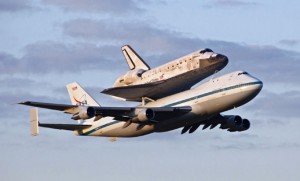

The final flight of the space shuttle Discovery around Washington DC yesterday provided a fitting send-off for the world’s most travelled spaceship.
Riding atop a modified 747, the flight also provided one of the final glimpses of what is among the world’s most unusual jumbo jets.
Though they don’t exactly look like standard 747s from the outside, NASA’s two Shuttle Carrier Aircraft (SCA) are even more unusual inside. In order to accommodate the shuttle’s weight, the downstairs passenger cabins are essentially hollow shells – lacking seats, overhead bins and even bathrooms and air conditioning.
Such weight saving measures, however, can hardly make up for the massive drag caused by carrying the shuttles, which weigh in the neighbourhood of 80 tonnes, depending on payload. With the shuttles attached, the carrier aircraft burns about 18,000kg of fuel an hour, roughly double the normal fuel burn, according to NASA. With that, the aircraft’s range is reduced to about 1850km from 10,100km and its altitude ceiling is reduced to about 15,000ft.
The first of the two SCAs, a 747-100 designated N905NA, was acquired from American Airlines in 1974 and modified over the next several years. The second, a 747-100SR, was purchased from Japan Airlines in 1988 and went into service as N911NA two years later.

Needless to say, modifying a 747 for such duty required a lot more than hollowing out the cabin. Two additional vertical stabilisers were added on either end of the standard horizontal stabilizers to help the aircraft stay steady, while three struts protrude from the top of the fuselage (two aft and one forward) to accommodate the shuttle, which is fitted atop the carrier aircraft using a large gantry-like structure known as a Mate-Demate Device. A flightcrew escape tunnel was also added to the aircraft, though this was later removed over concerns that escaping crew might be sucked in to one of the engines.
Over the years, the carrier aircraft were mainly used to ferry the shuttles between their landing sites, mostly in California, and the Kennedy Space Center in Florida, though they also undertook several more ambitious journeys. In 1983, N905 flew the space shuttle Enterprise to a tour of Europe, stopping to refuel in Canada and Iceland before reaching the UK and proceeding to West Germany and the Paris Airshow.
On occasion, the SCAs have also been used to ferry aircraft other than the space shuttles, most recently Boeing’s Phantom Ray unmanned combat air vehicle, which was flown from St Louis to Edwards Air Force Base in California in December 2010.
While the retired space shuttles are destined to become museum pieces, the erstwhile carriers face a less glorious fate. SCA N911NA was retired from NASA service in February and will be used a source of spare parts for NASA’s 747-based Stratospheric Observatory for Infrared Astronomy. After delivering the space shuttles Enterprise and Endeavour to their final resting places, SCA N905NA will join its sister aircraft on the scrap heap.
















pez
says:Scrap heap? Surely someone wants one with a shuttle (even a mock up) perched on top of it? Smithsonian perhaps? Such a waste.
Alan
says:Correction to the above story – From Wikipedia – The second SCA was developed in 1988, in the wake of the Challenger accident, NASA procured a surplus 747-100SR from Japan Airlines. Registered N911NA it entered service with NASA in 1990 after undergoing modifications similar to N905NA. It was first used in 1991 to ferry the new shuttle Endeavour from the manufacturers in Palmdale, California to Kennedy Space Center.